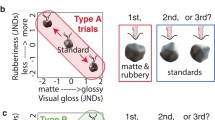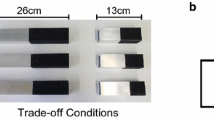Abstract
The object of this study was to see whether differences in texture influence grip force in the very early phase of grasping an object. Subjects were asked to pick up objects with different textures either blindfolded or sighted, while grip force was measured. Maximum force was found to be adjusted to suit the differences in coefficient of friction, confirming earlier results. Surprisingly, statistically significant differences in grip force were already present as short as 10 ms after touch onset in the blindfolded condition, despite the fact that only haptic information about the texture was available. This suggests that the haptic system is very fast in identifying a texture’s friction.
Access this chapter
Tax calculation will be finalised at checkout
Purchases are for personal use only
Similar content being viewed by others
References
Buckingham, G., Cant, J.S., Goodale, M.A.: Living in a material world: how visual cues to material properties affect the way that we lift objects and perceive their weight. J. Neurophysiol. 102, 3111–3118 (2009)
Cadoret, G., Smith, A.M.: Friction, not texture, dictates grip forces used during object manipulation. J. Neurophysiol. 75(5), 1963–1969 (1996)
Hermsdörfer, J., Li, Y., Randerath, J., Goldenberg, G., Eidenmüller, S.: Anticipatory scaling of grip forces when lifting objects of everyday life. Exp. Brain Res. 212, 19–31 (2011)
Johansson, R.S., Westling, G.: Roles of glabrous skin receptors and sensorimotor memory in automatic control of precision grip when lifting rougher or more slippery objects. Exp. Brain Res. 56(3), 550–564 (1984)
Acknowledgements
This work was supported by the Collaborative Project no. 248587, “THE Hand Embodied”, within the FP7-ICT-2009-4-2-1 program “Cognitive Systems and Robotics”.
Author information
Authors and Affiliations
Corresponding author
Editor information
Editors and Affiliations
Rights and permissions
Copyright information
© 2014 Springer-Verlag Berlin Heidelberg
About this paper
Cite this paper
Bergmann Tiest, W.M., Kappers, A.M.L. (2014). The Influence of Material Cues on Early Grasping Force. In: Auvray, M., Duriez, C. (eds) Haptics: Neuroscience, Devices, Modeling, and Applications. EuroHaptics 2014. Lecture Notes in Computer Science(), vol 8618. Springer, Berlin, Heidelberg. https://doi.org/10.1007/978-3-662-44193-0_49
Download citation
DOI: https://doi.org/10.1007/978-3-662-44193-0_49
Published:
Publisher Name: Springer, Berlin, Heidelberg
Print ISBN: 978-3-662-44192-3
Online ISBN: 978-3-662-44193-0
eBook Packages: Computer ScienceComputer Science (R0)




